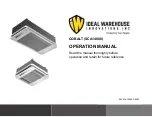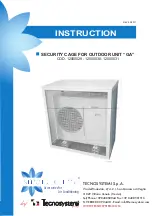
8 SYSAER R32
Safety Data
Difluoromethane R32
Precautions for safe handling:
container
Protect containers from physical damage; do not drag, roll, slide or drop.
Do not remove or deface labels provided by the supplier for the identification of the container contents.
When moving containers, even for short distances, use appropriate equipment eg. trolley, hand truck, fork
truck etc.
Secure cylinders in an upright position at all times, close all valves when not in use.
Provide adequate ventilation. Suck back of water into the container must be prevented.
Do not allow backfeed into the container.
Avoid suckback of water, acid and alkalis. Keep container below 50°C in a well ventilated place.
Observe all regulations and local requirements regarding storage of containers.
When using do not eat, drink or smoke.
Store in accordance with.
Never use direct flame or electrical heating devices to raise the pressure of a container.
Precautions for safe handling:
valves
Leave valve protection caps in place until the container has been secured against either a wall or bench or
placed in a container stand and is ready for use.
Damaged valves should be reported immediately to the supplier
Close container valve after each use and when empty, even if still connected to equipment.
Never attempt to repair or modify container valves or safety relief devices.
Replace valve outlet caps or plugs and container caps where supplied as soon as container is disconnected
from equipment.
Keep container valve outlets clean and free from contaminates particularly oil and water.
If user experiences any difficulty operating container valve discontinue use and contact supplier.
Never attempt to transfer gases from one container to another. Container valve guards or caps should be
in place.
Conditions for safe
storage, including any
incompatibilities
All electrical equipment in the storage areas should be compatible with the risk of a potentially explosive
atmosphere. Segregate from oxidant gases and other oxidants being stored. Containers should not be
stored in conditions likely to encourage corrosion. Stored containers should be periodically checked for
general conditions and leakage. Container valve guards or caps should be in place. Store containers in
location free from fire risk and away from sources of heat and ignition. Keep away from combustible
material.
Protection clothes
Wear boots, safety gloves and glasses or masks for facial protection.
Behaviour in case of leaks or
escapes
Never forget to wear protection clothes and brething apparatus. Isolate the source of the leakage,
provided that this operation may be performed in safety conditions. Any small quantity of
refrigerant which may have escaped in its liquid state may evaporate provided that the room is
well ventilated.In case of a large leakage, ventilate the room immediately. Stop the leakage with
sand, earth or any suitable absorbing material. Prevent the liquid refrigerant from flowing into
drains, sewers, foundations or absorbing wells since its vapours may create an asphyxiating atmosphere.
Disposal
The best procedure involves recovery and recycle. If this is not possible, the refrigerant shall be
given to a plant which is well equipped to destroy and neutralise any acid and toxic by-product
which may derive from its disposal.
Fire-fighting measures
Promptly isolate the scene by removing all persons from the vicinity of the incident if there is a fire. No
action shall be taken involving any personal risk or without suitable training.
Contact supplier immediately for specialist advice. Move containers from fire area if this can be done
without risk. Use water spray to keep fire-exposed containers cool. If involved in fire, shut off flow
immediately if it can be done without risk. If this is impossible, withdraw from area and allow fire to burn.
Fight fire from protected location or maximum possible distance. Eliminate all ignition sources if safe to do
so.
Special protective equipment
for fire-fighters
Fire-fighters should wear appropriate protective equipment and self-contained breathing apparatus
(SCBA) with a full face-piece operated in positive pressure mode. For incidents involving large quantities,
thermally insulated undergarments and thick textile or leather gloves should be worn.
Containers
If they are exposed to the fire, they shall be constantly cooled down by water sprays.
Containers may explode if they are overheated.
Содержание AC-RSR105R32HEC
Страница 2: ......
Страница 43: ...APPENDIX ANNEXE ANLAGE ALLEGATO ANEXO APPENDIX ANNEXE ANLAGE ALLEGATO ANEXO...
Страница 78: ......










































